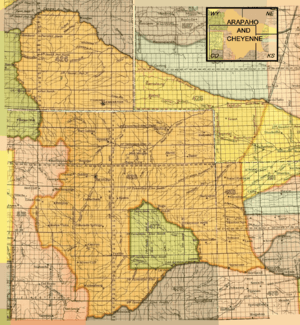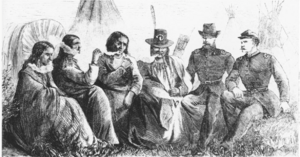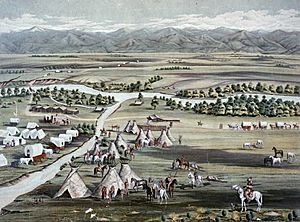Margaret Poisal facts for kids
Quick facts for kids
Margaret Poisal
|
|
|---|---|
| Born |
Margaret (Walking Woman) Poisal
1834 |
| Died | between 1883 and 1892 |
| Occupation | Interpreter |
| Years active | 1851–1883 |
| Spouse(s) | Thomas Fitzpatrick |
| Parent(s) | John Poisal and Snake Woman |
| Relatives | Chief Niwot (Chief Left Hand), maternal uncle |
Margaret Poisal (born 1834, died between 1883 and 1892) was a very important woman. She was the only woman who worked as an official witness, interpreter, and advisor at many meetings. These meetings and treaty councils happened near the Santa Fe Trail.
Margaret was the daughter of John Poisal, a French Canadian trapper, and Snake Woman, who was Arapaho. She went to a special school called a convent school. Later, she married Thomas Fitzpatrick, who was an Indian agent. They worked together to help Native American tribes and the United States government find peace. After Thomas died, Margaret kept working as an interpreter and peacemaker.
Contents
Who Was Margaret Poisal?
Margaret Poisal lived during a time of big changes in the American West. She helped bring people together.
Life on the Great Plains
Margaret grew up when the Arapaho and Cheyenne people lived across the Great Plains. In the early 1800s, fur trappers and traders came into the western frontier. The Arapaho and Cheyenne worked with these traders. They traded buffalo furs for goods along the Santa Fe Trail.
Starting in 1842, American pioneers began moving west to California and Oregon. This led to fewer buffalo and damaged the land. Other tribes, like the Lakota Sioux, also moved into new areas. With less game, the Arapaho had to find other ways to get food. They traded with settlers, asked Indian agents for food, or charged a fee for pioneers to cross their land.
Gold Rushes and New Settlers
Many more white people came west during the Pike's Peak Gold Rush in 1859. This happened after the earlier California Gold Rush (1848–1855). Buffalo hunters and gold seekers moved west. Then came homesteaders and railroad builders.
European Americans traveled through Native American hunting lands. They crossed the plains and mountains on trails like the Oregon Trail. People tried to find ways for native and non-native people to live together. So, the United States government and Native Americans made and remade many treaties.
Arapaho Life and Culture
The Arapaho people were friends with the Cheyenne. They lived north of the Arkansas River and near the Boulder Valley. Their land stretched from the Rocky Mountains to the Central and Southern Plains. They met white men who traded along the Santa Fe Trail. They traded things like guns for fur pelts.
The Arapaho treated men and women as equals. Both men and women helped manage family life. They also led important ceremonies and decided how their families followed tribal rules.
Margaret's Early Life and Education
Margaret Poisal, also known as Walking Woman, was born in 1834. Her father was John Poisal, a French Canadian hunter and trapper. Her mother was Snake Woman, who was the niece of Chief Niwot (Left Hand).
Family and Education
Margaret's father worked for the Bent brothers at Bent's Fort. This fort was on the Santa Fe Trail in Colorado. The Poisal family had five children who lived in both European-American and Arapaho ways. Margaret was one of the first Arapaho girls to get a formal American education. She went to a convent school in St. Louis, Missouri.
In 1857, her father raised cattle and horses at Cherry Creek. By 1860, John Poisal was a trader in Cherry Creek, Colorado. This area is now part of Denver, Colorado. His family, including Snake Woman and their younger children, lived with him.
Challenges and Survival
The family faced unfair treatment and hatred from miners and white settlers. Snake Woman was even attacked by two white men. John Poisal risked his life to save her. Margaret's brother, John, was also educated. He worked as a trader and spoke English, Arapaho, and Spanish.
Margaret's father died in 1861. Snake Woman and the children who were still at home joined the Arapaho at Sand Creek in Colorado. The Poisal children survived the terrible Sand Creek massacre. Because of this event, they each received 640 acres of land from the Treaty of the Little Arkansas in 1865.
Margaret's Marriages and Family
Margaret Poisal had a family and continued her important work.
Marriage to Thomas Fitzpatrick

In November 1849, Margaret married Thomas Fitzpatrick, also known as Broken Hand. He was a fur trader, scout, and Indian agent for the Southern Arapaho and Cheyenne people. They had two children: Andrew Jackson (Jack) Fitzpatrick, born in 1850, and Virginia Tomasine Fitzpatrick, born in 1854. Margaret and Thomas worked together to create "peaceful and helpful relationships" between the Arapaho and white Americans.
The Fitzpatricks lived in Westport, Missouri. From there, they often traveled to Native American villages on the Great Plains and along the Santa Fe Trail. In the fall of 1853, the Fitzpatricks traveled to Washington, D.C. with leaders from the Southern Arapaho and Southern Cheyenne tribes. Margaret was pregnant with their second child at this time. Thomas died in early February 1854. Their daughter, Virginia (Jennie) Tomasine, was born after his death.
Later Marriages and Life
Margaret inherited land and houses in Westport, Missouri, and over $10,000 from Thomas. On February 2, 1856, she married Lucious J. Wilmot, a gardener. By 1860, they lived in Leavenworth, Kansas with Margaret's children. That year, they also lived with Snake Woman's family in Denver for a while. Wilmot was a trader in Denver.
Margaret and Wilmot divorced because he handled their money poorly. She lost most of her inheritance from Thomas Fitzpatrick. By 1865, Margaret and her children lived in Leavenworth with her sister Mary and brother-in-law. Her children kept the Wilmot last name.
Jack and Jennie went to St. Mary's Mission School by 1866. Jennie later married John Meagher. Margaret lived with her daughter in 1877. She married a third time to a man named Adams by 1883. At that time, she was an interpreter at the Medicine Lodge treaty council. She was living on land she received from the Arapaho, possibly from the 1865 Sand Creek massacre reparations.
Margaret's Role in Treaties
Margaret Poisal played a key role in important treaties.
The Fort Laramie Treaty

Thomas Fitzpatrick helped organize the Fort Laramie Treaty Council in 1851. Margaret Poisal attended these meetings. Having women at the meetings showed that Native Americans trusted the process for a peaceful outcome. About 10,000 Native Americans from eight tribes attended.
The tribes agreed to stop attacking travelers on trails like the Oregon Trail. They also agreed to stop fighting with other tribes. The government promised to give them payments for 50 years. However, the United States Senate later changed the payments without asking the tribes. Both Native Americans and European Americans broke parts of the treaty. Fitzpatrick was also important in the Fort Atkinson Treaty Council of 1853.
A Unique Peacemaker
After Thomas Fitzpatrick died, Margaret Poisal continued his work. She represented the Southern Arapahos in treaty councils and meetings. These meetings happened along or near the Santa Fe Trail. She was an interpreter, witness, and advisor. At that time, she was the only woman doing these important jobs in the United States.
After the Pike's Peak Gold Rush, white miners and settlers moved onto Native American lands. Many did not want to be friends with native peoples. This led to more fighting with the Southern Cheyenne and Arapaho until 1875. Margaret's uncle, Chief Left Hand, was killed in November 1864 during the Sand Creek massacre. Snake Woman and her daughter Mary were at the camp during the massacre. Many Arapaho men were away hunting at the time.

In October 1865, she attended the Little Arkansas Treaty Council. She worked as a translator. She also helped negotiate for payments and land for the Sand Creek massacre survivors. Samuel A. Kingman, who was there, said she "faced many challenges."
Margaret worked as a negotiator and peacemaker for many years. Because of her efforts, major conflicts in Colorado and Kansas were avoided. In the end, many Native Americans were moved to Indian Territory (now Oklahoma). They had to give up their hunting and gathering traditions to become farmers.
Margaret's Later Years and Legacy
Margaret Poisal's last known public appearance was in 1883. She was an interpreter for the Arapaho group visiting Washington, D.C. She died by 1892, according to her brother John's estate papers.
She might have lived with her daughter, Virginia Tomasine "Jennie" Fitzpatrick Meager, in Indian Territory in her later years. Jennie was a public school teacher in Oklahoma. Her work helped children get an education without having to leave their communities for boarding schools.



